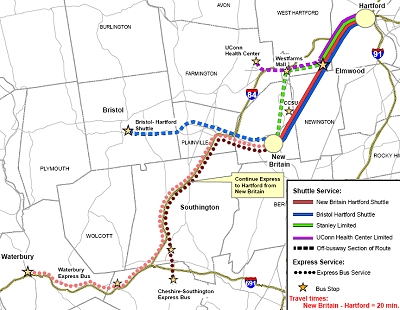Apparently 13 is a lucky number for Central Connecticut transit riders and businesses. That’s because after 13 years, Connecticut and the Federal Transit Administration have finally signed off on a Full Funding Grant Agreement for the Hartford-New Britain Bus Rapid Transit, scheduled to begin operations in 2014. The agreement, signed Monday at Central Connecticut State University, will allocate $275 million in federal New Starts funding, and sets the stage for construction to begin in March 2012. All told, the Federal Government will finance 80% of the $567 million project. Initial bids for construction contracts have come in approximately 23% under previous estimates.

TSTC has advocated for the project for over a decade and urged Gov. Malloy to endorse it earlier this year.
The project will eventually employ 4,000 people, see ridership of 16,000 a day, have headways of between 3-6 minutes and reduce congestion along I-84. Monday’s signing is a triumph for Governor Malloy, who has pushed hard to complete the state’s long-standing transit projects. The New Haven-Springfield Rail Line is also close to construction-ready.
Advocates are eager for the busway to attract new housing and offices, and help the state reduce future sprawl development. Connecticut recently targeted its initial round of transit-oriented development planning grants to several municipalities along the corridor.

Is there any way to stop this money wasting travesty? A light rail line that would take advantage of the fact that this is a rail right of way, be faster and might even COST LESS would be a better expenditure of money with bus feeders that also could connect with each other. So would a diesel MU operation that could share track with freight.
This line will have grade crossings. Someone should see how the grade crossings on the Los Angeles Orange line and South Miami Florida busways work with the severely restricted speeds. The Los Angeles Orange Line is capacity restricted because of the grade crossings. A lane mile of pavement costs as much as a track mile of track. The grading costs should be the same. In short a decent rail right of way will be trashed in favor a a busway that will cost far more than the original estimates. See the Los Angeles Harbor Freeway Busway and Pittsburgh West Busways for examples.
The information I have read suggests that a number of bus routes will feed into a common trunk, permitting high frequency on the trunk and one seat rides further out. Numerous studies indicate that people prefer one seat rides to transferring, as light rail or DMU would require. Also, buses will probably provide better distribution in Hartford than a light rail could and defintely better than DMU could.
Grade crossings for buses can be set up to work the same way grade crossings for rail work, if the investment is warranted.
That is the way the Ottawa busway, Los Angeles Harbor Freeway and El Monte high occupancy lane busways and Pittsburgh busways work to varying degrees of success. The ridership ranges from abysmal (Pittsburgh West Busway and Los Angeles Harbor Freeway Busway) to moderately decent (Ottawa, El Monte which started out as bus only, and Pittsburgh East Busway). These busways still carry fewer people than comparable light rail lines. I have ridden the South Miami busway and read reports on the Los Angeles Orange Line. Despite the high desirability of providing fast grade crossings, it has proved impossible on either busway for a variety of reasons. It will be interesting to see how the British busways (Cambridge, etc.) fare. The low capacity of the individual bus means high ongoing equipment and labor costs. What I have proposed is WORKING in Sacramento, California. While I prefer a one seat ride, I can accept scheduled transfers, especially if they give me a better ride over the major portion of the trip and a more reliable schedule.
I am very interested to see this conversation develop and I hope it does. In blogging Connecticut environmental news, I’ve heard lots of opinions on this and, frankly, it seems to me this money could be used in ways that would benefit the state of Connecticut, the unemployed here, traffic problems and solutions, much better than a busway will.
Stupidest. Idea. Ever. Busways no doubt work in some areas. I could see their utility, for instance, on a new Tappan Zee Bridge. Here? This is beyond idiotic. CDOT’s own engineers think this is a waste. It will never work. This is a boondoggle of the magnitude that ARC would have been. Malloy is an even bigger hack than Rowland was. I can’t believe transportation advocates of your stature would advocate such a waste of money.
[…] for the Hartford-New Britain Busway, a bus rapid transit project whose substantial federal funding was sewn up in November. TSTC has long supported plans for the busway (you know how we feel about BRT), and is heartened by […]